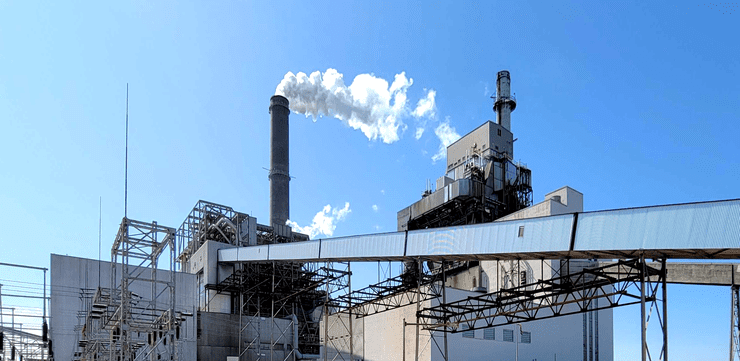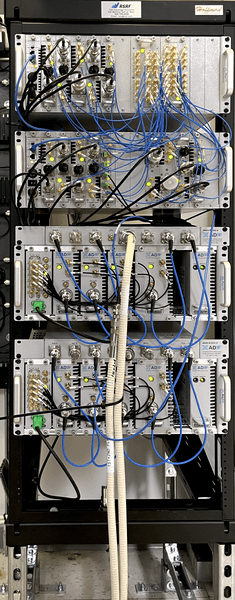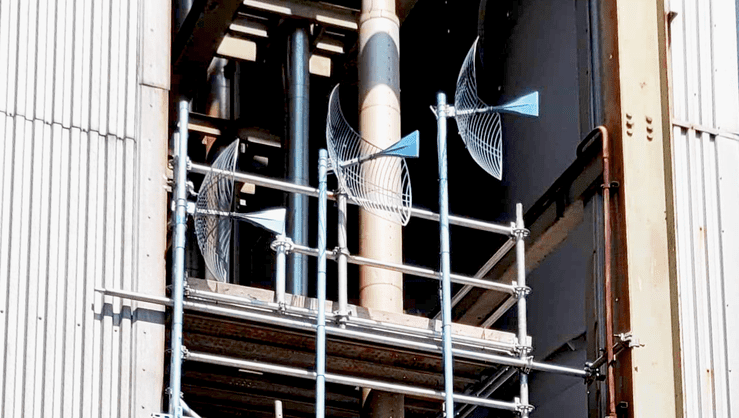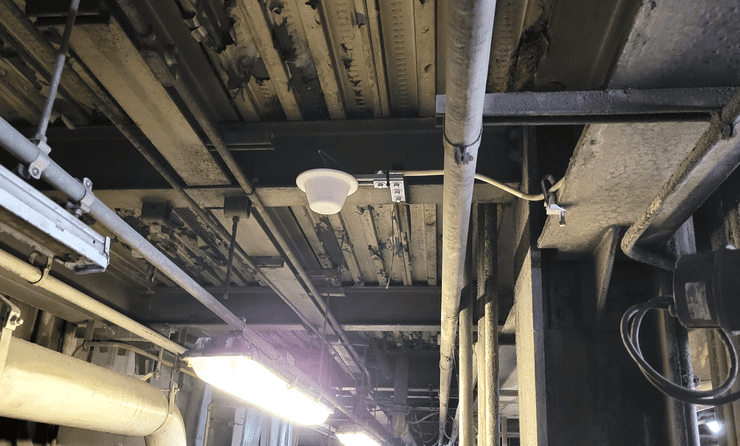Distributed Antenna System Solves Power Plant Communications Problem
Collaboration was the main success factor in the deployment of an all-carrier enterprise distributed antenna system (DAS) for a Midwest power plant.
The Problem
A power plant in the Midwestern U.S. (Figure 1) faced a formidable situation: The obsolescence of 3G cellular technology meant that the plant soon would lose its already unreliable cellular coverage, which was being provided through a legacy DAS.

It had become extremely difficult for people working at this sprawling, steel-and-concrete, multi-building site to communicate with others both within and outside of the plant about the status of projects. The increasing use of mobile phones by both visiting contractors and field personnel necessitated that the plant expand its cellular capabilities. It needed to go beyond just AT&T and include other carriers such as Verizon and T-Mobile.
“With 3G going away, AT&T was not being helpful. I decided to take it upon myself to get something engineered that would work,” one of the plant engineers explained. “With more and more cell phones here at the plant site, I wanted to get multiple services to people so they don’t have dropped calls and they can contact the people they need, when they need them, no matter where they are in the plant.”
This mission-critical facility relies on a landline for emergencies, which only dials 9-1-1. However, for everyday tasks, the 100-plus employees at the power plant needed a much more reliable solution than standing near a door to get an occasional cell signal.
Walkie-talkies historically have been used at the plant, but they were in short supply and sometimes didn’t work. The plant engineer’s goal was to have robust cellular coverage from multiple carriers inside the plant, so that everyone could use their cell phones and not have to rely on the walkie-talkies.
“With 3G being discontinued and AT&T not [upgrading] our system to 4G or even 5G, we were going to be without cell signal completely. We had to get something done quickly,” the plant engineer said.
A major pain point was that non-existent or unreliable cell service was affecting operational efficiency. Employees in the field working on technical problems sometimes need parts brought to them, an additional pair of hands to help them, or to speak with their supervisor in another building. Walking to and from other areas of the plant to accomplish any of these tasks would take as long as 30 minutes, resulting in a lot of downtime.
Whenever equipment is offline, the plant loses megawatts. “And when megawatts are being lost, we’re losing money,” the plant engineer emphasized.
Worker safety also was a concern. While there aren’t many emergencies, injuries do occur from time to time. The plant needs to provide medical help as quickly as possible. If someone should get hurt, his partner in the field should be able to call for help and then quickly turn his attention to his injured coworker, rather than run off to get help. “These are big safety factors that concerned the mechanics and the electricians, especially in the field,” the plant engineer explained.
The Solution
The power plant’s first step was to turn to a consulting engineering firm with which it had worked closely on other projects. Searching online for an enterprise DAS solution led them to RSRF, a nationwide provider of DAS that previously had deployed systems for several other utilities. The power plant engineer was impressed by RSRF’s engineering-based approach to the solutions it had designed and installed. Together they began to engage on a new DAS project for the plant.
RSRF dispatched a radio frequency (RF) technician to do a site audit and collect measurements of cellular signals. The technician immediately saw why the plant’s existing technology was failing: it was only able to work with specific frequencies that were no longer the primary ones being used in the area. Although it was well-suited for the time when it was deployed, it could not continue to function once 3G technology was sunset. In fact, the new DAS that RSRF eventually deployed for the power plant is considered future-proof, because it allows for updated modules to be installed as cellular technology evolves.
During initial discussions, the scope of the project was limited, but later grew to include 15 buildings: three main facilities and 12 outlying, smaller buildings. The site survey took two days and included walking the facility and identifying where cell coverage needed to be present, as well as taking signal readings from the roof of AT&T, Verizon, and T-Mobile, and later analyzing them.
This was a very unique project that truly demanded collaboration among four groups: the RSRF team, the consulting engineer, a cabling company, and the power plant. In addition to designing and engineering DAS projects, RSRF usually installs them, too. However, for this project, the power plant wanted to use its own cable installer.
RSRF initially proposed a robust design of active DAS platforms—ADRF model ADXV for the three larger buildings, which were to be networked with fiber. However, the end-user wanted the three buildings to have their own independent systems, each with its own head-end (Figure 2). This added to the cost, but RSRF altered its design to accommodate.

Another unique aspect of this project is the use of two different platforms on one site. For the 12 smaller buildings, some of which were 5,000 square feet or less, RSRF specified more cost-feasible passive-technology—Nextivity Go-X signal boosters.
“For a facility like this with multiple buildings, the ADRF platform is really the appropriate solution. It has a centralized head-end and from there its fiber-optic cable out to local amplifiers, so you’re almost limitless in the amount of territory you can cover because of the distance fiber can go. One of the key features of this system is its ability to expand into not only new areas of the same building, but into a completely new building, if needed,” said Andrew Roberts, director of RF engineering at RSRF.
Once the job started, RSRF dispatched a construction manager to the site to oversee the installation (Figure 3). RSRF provided the cabling contractor with a very thorough and accurate, software-based design plan and cabling diagram, which showed exactly how the DAS was to be configured.

One aspect of the installation that made it challenging was that the buildings didn’t have traditional risers, or spaces that could be accessed for the installation of vertical cable runs as you would find in a traditional office building. Instead, more of the equipment was mounted in one central tech room, with cables running horizontally and then vertically when able to get to areas for coverage. Considering the harsh environment of the plant, special attention was also paid to ensure the equipment met the necessary temperature and dust requirements for operation.
RSRF’s engineers inspected the cable company’s work, and performed the commissioning and optimization of the systems as they were completed and brought online. Commissioning involves configuring the DAS so that the system works in compliance with the carriers’ requirements. Optimization verifies that the system captures the signal by ensuring donor antennas are correctly aligned to the appropriate donor source. If not optimal, it could cause some performance issues, specifically with the signal quality.
“That’s our expertise when the equipment is installed, to make sure those levels are where they need to be so we get allowable transmission service when we’re sending and receiving the signal back at the cell tower,” said Tom Hernandez, vice president of sales and operations at RSRF.
The result of the power plant’s new enterprise DAS is that it was able to boost LTE signals for all three major carriers, providing all-carrier signal coverage inside the buildings for the first time and ensuring connectivity for users inside. RSRF also brought AT&T FirstNet into the power plant—a network specifically for public safety/first responders.
“Every one of the major frequency bands were found outside the building, and as such we decided to utilize all four of them. If a carrier does decide they want to change which band is the priority band, as it were, we’re able to still utilize that frequency no matter what the carrier does on their back end. If we have that signal available, we want to be able to utilize it so that every possible signal that could possibly reach the end-users’ devices, does,” explained Frank Cifone, RF systems analyst at RSRF.
The Results
When the plant engineer first began thinking about an upgrade, he initially thought the plant could only get one carrier’s coverage boosted throughout the plant. He was excited that RSRF was able to design a DAS that provided coverage for all three major carriers’ signals. He also embraced the way RSRF provided engineered design plans in advance of the installation. “It’s really what pushed me towards RSRF,” he said.
The impact of the DAS was immediate as soon as it was powered on. Not only employees with company phones on AT&T service, but everyone who uses a personal phone for work functions on any of the major providers, were thrilled. “They didn’t have to walk outside to try to get a signal. They have it inside the plant and they’re ecstatic,” the plant engineer said.
The ability to make calls and send texts is having a major impact on efficiency (Figure 4). Plant employees are able to call for assistance or to request a part be brought to them. In one case, as a large evaporator was being installed, mechanics in the field were placing calls to the plant engineer with questions and he was able to connect them with the manufacturer via speaker for a three-way conversation, and very easily answer their questions right away.

It is a huge advantage being able to use cell phones reliably during a process called “equipment checkouts,” where the operation of equipment is simulated by powering it on and then off again. The phones help plant employees communicate along every step of the procedure, including taking and sending screenshots and other images. “From a business standpoint, they use it all the time. It’s like they never had anything else really,” the plant engineer described.
In addition to audio-only calls, employees in the field can use FaceTime or another video calling app to do remote, real-time troubleshooting with more experienced mechanics or electricians. The field employee can remotely show his contact what he is working on and ask if it looks normal or request help. The plant engineer said this is a great testimonial for using cell phones instead of walk-talkies.
The quality of the DAS has been standing up very well in the harsh environment of the power plant, where heat and dust is often present, reported the plant engineer. “And we’ve had no issues whatsoever. It’s a lot more robust than I thought it was going to be,” he said.
The plant engineer views the project as a “total success.” Except for some “nooks and crannies” where there is too much concrete, steel, and rotating equipment, the plant now has coverage practically everywhere.
“RSRF helped us out quite a bit in getting where we needed to be. It was really nice how they were available to explain the equipment to us and how everything worked. If we have any questions, they’re always available to answer our call,” the plant engineer said. “I would definitely recommend RSRF to other people. I would use this as an example of a success story here at the power plant because not all installs are a success out here.”
—This article was contributed to POWER by RSRF, a turn-key cellular DAS, private LTE, and public safety solutions provider with a nationwide team and headquarters in Santa Ana, California.